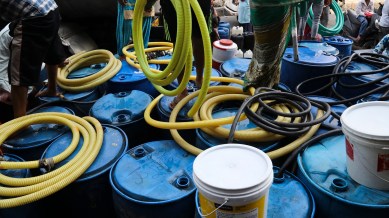Stay updated with the latest - Click here to follow us on Instagram
Groundwater most ‘exploited’ at Delhi’s VIP enclaves, shows report
In Delhi, prior permission is required to extract groundwater for any purpose. Most of the city’s groundwater, close to 80%, is used for domestic purposes, going by the report.

The New Delhi revenue district, including parts of Chanakyapuri, Vasant Vihar and the Delhi Cantonment area, remains the most exploited in terms of groundwater extraction in the city, extracting far more than it recharges.
Delhi, however, has recorded a fall in groundwater extraction in this assessment year compared to last year, according to the Dynamic Groundwater Resources of India 2023 report of the Central Groundwater Board (CGWB) released Friday.
The total groundwater extraction in the city has fallen from 0.36 bcm (billion cubic metres) last year to 0.34 bcm this year, with 9 out of 11 revenue districts recording a fall compared to 2022. Only North and Northeast Delhi saw an increase.
But the city’s annual groundwater recharge has also fallen — from 0.41 bcm last year to 0.38 bcm this year — which means the extractable groundwater resource that is a portion of this recharge, has also decreased. With groundwater recharge falling, the stage of extraction (a percentage of groundwater extracted against the recharge) was 99.13% this year, up from 98.16% last year.
The New Delhi district has the highest stage of extraction — 137.79% — which means it extracts 3,612.52 hectare metre of water, when the extractable groundwater from what is recharged annually is only 2,621.74 hectare metre, the report shows.
While New Delhi’s annual extraction this year has fallen from 3,713 hectare metre last year, the district’s stage of extraction had been the highest in the city last year as well.
Similarly, four other districts are overexploited — North Delhi, Northeast Delhi, Shahdara, and South Delhi. Around 41.49% of the 1487.61 sqkm of the city’s total area is considered to be ‘over-exploited’, according to the report.
North Delhi’s extraction is up from 4,540.58 hectare metre last year to 4,592.99 hectare metre this year, while Northeast Delhi’s extraction is up from 1,683.63 hectare metre last year to 1,690.38 hectare metre this year.
Of the 11 revenue districts, only a single one, Northwest Delhi, is in the ‘safe’ category, with a stage of extraction of 65.96%.
The report notes that exploited assessment units in Northwest India, including Punjab, Haryana, Delhi and Western UP, where “replenishable resources are abundant”, are on account of “indiscriminate withdrawal of groundwater leading to overexploitation”.
In Delhi, prior permission is required to extract groundwater for any purpose. Most of the city’s groundwater, close to 80%, is used for domestic purposes, going by the report.
On why the recharge and, hence the extractable groundwater, was lower this year compared to last year, and some areas have seen an increase in extraction, an official in the CGWB said, “Recharge may have decreased in some areas due to less rainfall or because pavemented areas may have increased. In parts of the city where extraction may have increased, tubewells may have increased and pumping has increased. Water levels are overall improving since extraction is declining in most of the wells.”